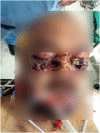Penetrating Sugarcane Injury to Brain via Orbit: A Case Report
- PMID: 38576503
- PMCID: PMC10990701
- DOI: 10.13004/kjnt.2024.20.e4
Penetrating Sugarcane Injury to Brain via Orbit: A Case Report
Abstract
Penetrating brain trauma is rare. We present a unique case involving a sugarcane injury that penetrated the brain via the orbit following a road traffic accident. A 32-year-old male arrived at our emergency department with a penetrating injury to his left eye. A non-contrast computerized tomography (NCCT) scan of the head showed a foreign body in the left orbit, extending to the frontal lobe. Left frontotemporal craniotomy, anterior cranial fossa exploration, retrieval of the foreign body (a sugarcane piece), and dural repair of the anterior cranial fossa were performed. The patient was discharged and showed positive progress on follow-up. Penetrating trauma to the eyes and brain can be fatal, leading to vision loss. Therefore, early surgical intervention and close coordination between ophthalmologists and neurosurgeons are imperative.
Keywords: Agriculture; Brain injuries, traumatic; Head injuries, penetrating; Ocular trauma; Saccharum.
Copyright © 2024 Korean Neurotraumatology Society.
Conflict of interest statement
Conflict of Interest: The authors have no financial conflicts of interest.
Figures






Similar articles
-
SURGICAL MANAGEMENT OF A PENETRATING BRAIN WOUND AND ASSOCIATED PERFORATING OCULAR INJURY CAUSED BY A LOW-VELOCITY SHARP METALLIC OBJECT: A CASE REPORT AND LITERATURE REVIEW.Acta Clin Croat. 2022 Nov;61(3):537-546. doi: 10.20471/acc.2022.61.03.21. Acta Clin Croat. 2022. PMID: 37492370 Free PMC article. Review.
-
Removal of a Penetrating Tree Branch in the Orbitofrontal Region-A Unique Application of an Orbitofrontal Craniotomy Through a Supraciliary Brow Approach.Oper Neurosurg. 2021 Sep 15;21(4):E386-E391. doi: 10.1093/ons/opab259. Oper Neurosurg. 2021. PMID: 34333660
-
An unusual case of intra orbital foreign body; diagnosis, management, and outcome: a case report.BMC Surg. 2019 Jul 4;19(1):76. doi: 10.1186/s12893-019-0536-2. BMC Surg. 2019. PMID: 31272434 Free PMC article.
-
Penetrating intraorbital wooden foreign bodies involving the right frontal lobe of the brain: A rare case report.Surg Neurol Int. 2024 Nov 15;15:418. doi: 10.25259/SNI_668_2024. eCollection 2024. Surg Neurol Int. 2024. PMID: 39640357 Free PMC article.
-
The Role of Intraoperative Cerebral Angiography in Transorbital Intracranial Penetrating Trauma: A Case Report and Literature Review.World Neurosurg. 2017 Jan;97:761.e5-761.e10. doi: 10.1016/j.wneu.2016.09.083. Epub 2016 Sep 28. World Neurosurg. 2017. PMID: 27693768 Review.
Cited by
-
Agricultural Farm-Related Head Injuries in Rural India: A Case Series.Korean J Neurotrauma. 2025 Apr 22;21(2):137-151. doi: 10.13004/kjnt.2025.21.e11. eCollection 2025 Apr. Korean J Neurotrauma. 2025. PMID: 40353283 Free PMC article.
-
Transcranial-Penetrating Craniocerebral Injury Inflicted by a Nail Gun: A Technical Case Report.Korean J Neurotrauma. 2024 Jul 16;20(3):191-197. doi: 10.13004/kjnt.2024.20.e24. eCollection 2024 Sep. Korean J Neurotrauma. 2024. PMID: 39372112 Free PMC article.
References
-
- Bard LA, Jarrett WH. Intracranial complications of penetrating orbital injuries. Arch Ophthalmol. 1964;71:332–343. - PubMed
-
- Devi BI, Bhatia S, Kak VK. Penetrating orbitocranial injuries--report of two cases. Indian J Ophthalmol. 1993;41:84–86. - PubMed
-
- Gennarelli TA, Champion HR, Sacco WJ, Copes WS, Alves WM. Mortality of patients with head injury and extracranial injury treated in trauma centers. J Trauma. 1989;29:1193–1201. - PubMed
Publication types
LinkOut - more resources
Full Text Sources

